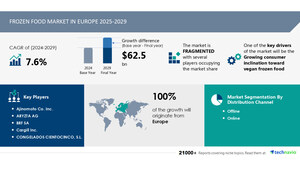NEW YORK, May 10, 2024 /PRNewswire/ -- The global electric commercial vehicle market market size is estimated to grow by USD 166.58 bn from 2023-2027, according to Technavio. The market is estimated to grow at a CAGR of over 26.02% during the forecast period.
For more insights on the forecast market size and historic data (2017 - 2021) - Buy Report
Report Coverage |
Details |
Base year |
2022 |
Historic period |
2017 - 2021 |
Forecast period |
2023-2027 |
Growth momentum & CAGR |
Accelerate at a CAGR of 26.02% |
Market growth 2023-2027 |
USD 166.58 billion |
Market structure |
Fragmented |
YoY growth 2022-2023 (%) |
25.02 |
Regional analysis |
APAC, North America, Europe, Middle East and Africa, and South America |
Performing market contribution |
APAC at 48% |
Key countries |
US, China, Germany, UK, and France |
Key companies profiled |
AB Volvo, Anhui Jianghuai Automobile Group Co. Ltd., BYD Co. Ltd., Daimler Truck AG, Ford Motor Co., General Electric Co., Hyundai Motor Co., Mahindra and Mahindra Ltd., NFI Group Inc., Nissan Motor Co. Ltd., Olectra Greentech Ltd, PACCAR Inc., Proterra Inc., Renault SAS, Rivian Automotive Inc., Tata Motors Ltd., Tesla Inc., Toyota Motor Corp., Volkswagen AG, and Xiamen King Long United Automotive Industry Co. Ltd. |
Market Driver
In the dynamic electric commercial vehicle (ECV) market, vendors employ various strategies, including collaborations, partnerships, and mergers and acquisitions (M&A), to develop advanced ECVs and expand their technological and geographic reach. For instance, in June 2020, Ford Motor Co. And Volkswagen AG agreed to produce high-performing ECVs for European customers by 2023. BYD Company Ltd. Also made strides with lithium-ion batteries, NMC batteries, and other components. Key players focus on battery capacity (60–120 kWh), power, range, and emissions targets to meet OEM demands for electric buses, trucks, vans, and other commercial vehicles. The ECV market encompasses various sectors, including farming, excavators, building materials, and road transport, with key players like Elimen Group, Flash Electronics, and VIA Motors adhering to safety regulations, such as the NHTSA's SAFE vehicles rule and the EAVX's JPY 2 emissions standards. The shift from ICE fleets to electric vehicles is driven by operational cost savings, with electric buses and commercial vehicles offering advantages over diesel, petrol, and other traditional power sources.
Market Challenges
- The electric commercial vehicle (ECV) market is experiencing growth due to rising fuel costs and emission regulations. However, the higher cost of ECVs compared to conventional vehicles, particularly electric buses, may hinder adoption. Key considerations include interconnectivity, operation and maintenance, zero carbon emission, traffic congestion, fuel consumption, and charging infrastructure. Innovative business models, leasing, and fleet management solutions are mitigating upfront costs. Climate change, battery technology, and driving ranges are also significant factors. Operational expenses, range anxiety, and limited charging infrastructure are challenges. Urban delivery services and last-mile solutions are major applications. Geopolitical tensions and financial resources impact market stability.
Research report provides comprehensive data on impact of trend, driver and challenges - Request a sample report!
Segment Overview
This electric commercial vehicle market market report extensively covers market segmentation by
- Product
- 1.1 LCVs
- 1.2 Buses
- 1.3 Heavy and medium commercial vehicles
- Type
- 2.1 Battery electric vehicle (BEV)
- 2.2 Plug-in hybrid electric vehicle (PHEV)
- 2.3 Fuel cell electric vehicle (FCEV)
- Geography
- 3.1 APAC
- 3.2 North America
- 3.3 Europe
- 3.4 Middle East and Africa
- 3.5 South America
1.1 LCVs- The electric commercial vehicle (ECV) market faces uncertainty due to geopolitical tensions and fluctuating financial resources. Upfront costs of electric LCVs remain a significant barrier for fleet operators, despite their operational efficiency and potential for reducing CO2 emissions. Conventional counterparts, such as internal combustion engine (ICE) fleet, continue to dominate the road transport sector. However, advances in wireless charging technology and the development of charging infrastructure are mitigating range anxiety and limited charging infrastructure concerns. In the long-haul transportation sector, electric LCVs are gaining traction due to their compact, lightweight design and cost-effectiveness. Battery availability, particularly for larger battery capacities such as 60–120 kWh, remains a challenge. Lithium-ion batteries and NMC batteries are popular choices due to their self-heating rate and power output. Emissions targets and regulations, such as the NHTSA's SAFE vehicles rule, are driving OEMs to invest in ECVs. Key players in the ECV market include Guangdong Province's Elimen Group and Flash Electronics, as well as VIA Motors, EAVX, and JPY 2. These companies are developing advanced driver-assistance systems (ADAS), artificial intelligence (AI), and the Internet of Things (IoT) to enhance the functionality and appeal of electric LCVs. However, the market's growth is not without challenges, including the availability and cost of EV components and the ongoing transition from ICE fleet to electric fleet.
For more information on market segmentation with geographical analysis including forecast (2023-2027) and historic data (2017-2021) - Download a Sample Report
Research Analysis
The Electric Commercial Vehicle (ECV) market is experiencing significant growth in the road transport sector. ECVs, including buses, vans, trucks, and tractor/harvesters, are gaining popularity due to their environmental benefits, such as reduced CO2 emissions. Electric drivetrains, powered by electricity from the grid or on-board batteries, replace traditional Internal Combustion Engines (ICE) in these vehicles. Charging times for ECVs are a crucial consideration, with advancements in battery technology and charging infrastructure continually improving. Consumer awareness and the shift towards sustainable transportation solutions are driving demand for Electric Vans and other ECVs in the largest market segments, such as last mile delivery. Regulatory bodies like the NHTSA and the implementation of safety rules, such as the SAFE vehicles rule, ensure the production of safe and reliable ECVs. Companies like VIA Motors, EAVX, and others are leading the charge in this evolving market. The JPY 2 market, traditionally dominated by ICE fleet, is also witnessing a transition towards electric.
Market Research Overview
The Electric Commercial Vehicle (ECV) market is experiencing significant growth due to increasing environmental concerns and the need for sustainable transportation solutions. Companies are investing heavily in the development and production of electric commercial vehicles, such as buses, trucks, and vans. These vehicles offer numerous benefits, including reduced emissions, lower operating costs, and improved performance. The use of advanced technologies like lithium-ion batteries and regenerative braking systems is making ECVs more efficient and cost-effective. Furthermore, governments and organizations are implementing policies and incentives to promote the adoption of electric commercial vehicles. The market is expected to continue growing in the coming years, with major players including automotive OEMs and technology companies. The EV sector, particularly the commercial vehicle segment, is poised for substantial expansion.
Table of Contents:
1 Executive Summary
2 Market Landscape
3 Market Sizing
4 Historic Market Size
5 Five Forces Analysis
6 Market Segmentation
- Product
- LCVs
- Buses
- Heavy And Medium Commercial Vehicles
- Type
- Battery Electric Vehicle (BEV)
- Plug-in Hybrid Electric Vehicle (PHEV)
- Fuel Cell Electric Vehicle (FCEV)
- Geography
- APAC
- North America
- Europe
- Middle East And Africa
- South America
7 Customer Landscape
8 Geographic Landscape
9 Drivers, Challenges, and Trends
10 Company Landscape
11 Company Analysis
12 Appendix
About Technavio
Technavio is a leading global technology research and advisory company. Their research and analysis focuses on emerging market trends and provides actionable insights to help businesses identify market opportunities and develop effective strategies to optimize their market positions.
With over 500 specialized analysts, Technavio's report library consists of more than 17,000 reports and counting, covering 800 technologies, spanning across 50 countries. Their client base consists of enterprises of all sizes, including more than 100 Fortune 500 companies. This growing client base relies on Technavio's comprehensive coverage, extensive research, and actionable market insights to identify opportunities in existing and potential markets and assess their competitive positions within changing market scenarios.
Contacts
Technavio Research
Jesse Maida
Media & Marketing Executive
US: +1 844 364 1100
UK: +44 203 893 3200
Email: [email protected]
Website: www.technavio.com/
SOURCE Technavio

WANT YOUR COMPANY'S NEWS FEATURED ON PRNEWSWIRE.COM?
Newsrooms &
Influencers
Digital Media
Outlets
Journalists
Opted In






Share this article